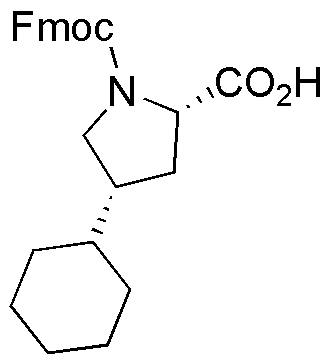(2S,4R)-Fmoc-4-cyclohexyl-pyrrolidine-2-carboxylic acid is widely utilized in research focused on:
- Peptide Synthesis: This compound serves as a protective group in the synthesis of peptides, allowing for selective reactions and enhancing the efficiency of the process.
- Drug Development: Its structural properties make it valuable in the design of new pharmaceuticals, particularly in creating compounds with improved bioavailability and stability.
- Bioconjugation: It is used in attaching biomolecules to surfaces or other molecules, facilitating the development of targeted drug delivery systems.
- Research in Neuroscience: The compound's unique structure can be utilized in studies related to neuroactive peptides, potentially leading to advances in treatments for neurological disorders.
- Material Science: Its properties can be leveraged in the creation of novel materials, such as polymers with specific mechanical or thermal characteristics.
General Information
Properties
Safety and Regulations
Applications
(2S,4R)-Fmoc-4-cyclohexyl-pyrrolidine-2-carboxylic acid is widely utilized in research focused on:
- Peptide Synthesis: This compound serves as a protective group in the synthesis of peptides, allowing for selective reactions and enhancing the efficiency of the process.
- Drug Development: Its structural properties make it valuable in the design of new pharmaceuticals, particularly in creating compounds with improved bioavailability and stability.
- Bioconjugation: It is used in attaching biomolecules to surfaces or other molecules, facilitating the development of targeted drug delivery systems.
- Research in Neuroscience: The compound's unique structure can be utilized in studies related to neuroactive peptides, potentially leading to advances in treatments for neurological disorders.
- Material Science: Its properties can be leveraged in the creation of novel materials, such as polymers with specific mechanical or thermal characteristics.
Documents
Safety Data Sheets (SDS)
The SDS provides comprehensive safety information on handling, storage, and disposal of the product.
Product Specification (PS)
The PS provides a comprehensive breakdown of the product’s properties, including chemical composition, physical state, purity, and storage requirements. It also details acceptable quality ranges and the product's intended applications.
Certificates of Analysis (COA)
Search for Certificates of Analysis (COA) by entering the products Lot Number. Lot and Batch Numbers can be found on a product’s label following the words ‘Lot’ or ‘Batch’.
*Catalog Number
*Lot Number
Certificates Of Origin (COO)
This COO confirms the country where the product was manufactured, and also details the materials and components used in it and whether it is derived from natural, synthetic, or other specific sources. This certificate may be required for customs, trade, and regulatory compliance.
*Catalog Number
*Lot Number
Safety Data Sheets (SDS)
The SDS provides comprehensive safety information on handling, storage, and disposal of the product.
DownloadProduct Specification (PS)
The PS provides a comprehensive breakdown of the product’s properties, including chemical composition, physical state, purity, and storage requirements. It also details acceptable quality ranges and the product's intended applications.
DownloadCertificates of Analysis (COA)
Search for Certificates of Analysis (COA) by entering the products Lot Number. Lot and Batch Numbers can be found on a product’s label following the words ‘Lot’ or ‘Batch’.
*Catalog Number
*Lot Number
Certificates Of Origin (COO)
This COO confirms the country where the product was manufactured, and also details the materials and components used in it and whether it is derived from natural, synthetic, or other specific sources. This certificate may be required for customs, trade, and regulatory compliance.


